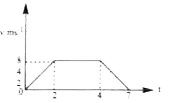A particla starting from rest undergoes acceleration given by a=|t−2| m/s2 where t is time in sec. Find velocity of particle after 4 sec. is :-Solution in Gujrati
The correct Answer is:4 m/s
Step by step video & image solution for A particla starting from rest undergoes acceleration given by a=|t-2|" m/s"^(2) where t is time in sec. Find velocity of particle after 4 sec. is :- by Physics experts to help you in doubts & scoring excellent marks in Class 12 exams.
Updated on:21/07/2023Topper's Solved these Questions
- RACEBOOK - ALLEN CHAPTER - RACEEXERCISE - Basic Maths (NEWTONS LAWS OF MOTION)
49 Videos
- RACEBOOK - ALLEN CHAPTER - RACEEXERCISE - Basic Maths (FRICTION)
13 Videos
- RACEBOOK - ALLEN CHAPTER - RACEEXERCISE - Basic Maths (Units, Dimensions & Measurements)
37 Videos
- NEWTONS LAWS OF MOTIONBOOK - ALLEN CHAPTER - NEWTONS LAWS OF MOTIONEXERCISE - EXERCISE-III
28 Videos
- SIMPLE HARMONIC MOTIONBOOK - ALLEN CHAPTER - SIMPLE HARMONIC MOTIONEXERCISE - Example
1 Videos
Similar Questions
There are two bodies A & B of same mass body A is at rest while body B is under going uniform motion, which is correct statements ?
View SolutionA block of mass 1 kg is plased on a surgace for which μs=0.2&μk=0.15, an external force F is applied on the block as shown in the figure, using g=10m/sec2, find:
(a) The force of friction on block
(b) Its acceleration
(i) When F=1 N
(ii) When F=2 N
(iii) When F=2.5 N

View SolutionWhich one of the following is not a fundamental quantity ?
View SolutionAssertion: The driver in a vechicle moving with a constant speed on a straight road is in a non-inertial frame of referance.
Reason: A reference frame in which Newton's laws of motion are applicable is non-inertial.
View SolutionA rod with rectangular cross section oscillates about a horizontal axis passing through one of its ends and it behaves like a seconds pendulum, its length will be
View SolutionA particle starts from rest and moves with an acceleration of a={2+|t−2|}m/s2 The velocity of the particle at t=4 sec is
View SolutionThe velocity of a particle at t=0 "is"vecU = 4hati+3hatj"m"//"sec" and a constant acceleration is veca=6hati+4hatj"m"//"sec"^(2) . Find the velocity and displacement of the particle at t=2 sec.
View SolutionA particle starts from rest with a time varying acceleration a=(2t-4) . Here t is in second and a in m//s^(2) The velocity time graph of the particle is
View SolutionA particle starts from rest on a straight path, Its acceleration is linearly varying with time, such that velocity of the particle at t=2 sec and t=4 sec is 6ms−1 respectively. Find acceleration of the particle at t=i sec.
View SolutionFind the modulus of average acceleration (in m/s2) of the block from time t = 2 sec to t = 4 sec.
View Solutionकिसी कण का त्वरण a=3t2+2t+2m/s2 द्वारा दिया जाता है, यहाँ t समय है। यदि कण t=0 पर v= 2 मी/सै से चलना प्रारम्भ करता है, तब 2 सैकण्ड पश्चात् कण का वेग होगा
View SolutionFigure given here shows the variation of velocity of a particle with time.

Find the following:
(i) Displacement during the time intervals.
(a) 0 to 2 sec., (b) 2 to 4 sec. and (c) 4 to 7 sec
(ii) Accelerations at
(a)t = 1 sec, (b) t = 3 sec. and (c)t = 6 sec.
(iii) Average acceleration
(a) between t = 0 to t = 4 sec.
(b) between t = 0 to t = 7 sec.
(iv) Average velocity during the motion.
View SolutionThe acceleration 'a' in m/s2 of a particle is given by a=3t2+2t+2 where t is the time. If the particle starts out with a velocity u=2 m/s at t=0, then the velocity at the end of 2 second is
View SolutionThe acceleration 'a' in m//s^2 of a particle is given by a=3t^2+2t+2 where t is the time. If the particle starts out with a velocity u=2 m/s at t=0, then the velocity at the end of 2 second is
View SolutionThe acceleration 'a' in m//s^(2) of a particle is given by a= 3t^(2)+2t+2 where t is the time. If the particle starts out with a velocity u=2 m//s at t=0 , then the velocity at the end of 2 second is
View SolutionThe displacement s of a particle at time t is given by s = t3 -4t2 -5t. Find the velocity and acceleration at t=2 sec
View Solution
